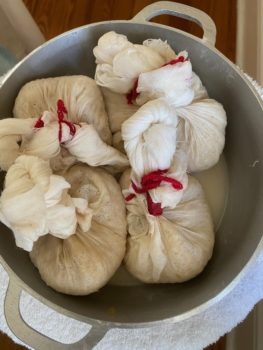. . .Remembering my messy, magical, healing week of “panchakarma” — when ayurveda pulls out all the stops

The instructions said, “Bring clothes you don’t mind getting oily.” I recalled from experiencing panchakarma, ayurveda’s signature detox regimen, previously that it involves oil massage, oil in the nostrils, oil streamed onto the forehead, oil in the hair, even something called basti, an herbalized oil enema. Other than that last one, all this lubricating is really pleasant, and even basti isn’t as bad as it sounds. I opted to do this process with Dr. Scott Gerson in Dunedin, Florida, because he’s a Western internist and ayurvedic vaidya. I was already a student of ayurveda, but here’s what I learned — or re-learned — that can make a huge difference in anybody’s life:
- Ayurveda comes from ancient India, but it belongs to people of every era and location. Translated from Sanskrit as “science of life,” ayurveda contends that the fundamental cause of impaired health is forgetting who we are, an immortal spirit inhabiting a physical body. The spirit that’s our true identity is also the essence of everybody else, including the people we disagree with and the animals some people eat.
- You’re not a diva in realizing that you’re unique. Ayurveda is adamant about individuality. Two people might have the same pathology, but why each one has it, how it expresses, and what they need to do to bring their bodies into balance may be different. These differences are explained in the theory of doshas, three energies present in all of us, but in differing degrees. The doshas are:
- Vata ~ comprised of air and ether. Vata people tend to be slight of build, creative and spontaneous when in balance, spaced out and anxious when they’re not. Vata overload can exhibit as dryness throughout the body, gas, constipation, creaking joints, sensitivity to noise, and always feeling cold.
- Pitta ~ the fire and water dosha. Pittas are of medium build and often muscular. In balance, they can thrive as executives, stretegists, or litigators, taking charge and getting things done. Out of balance, they revert to anger and sarcasm, and are prone to inflammation, skin eruptions, ulcers, acid indigestion, and diarrhea.
- Kapha ~ composed of earth and water. People endowed with kapha tend to be big-boned and fleshy. The slowest moving dosha, kapha generally imparts excellent health, with the exception of upper respiratory troubles and a tendency to retain water and gain weight. In balance, kapha people are stable, patient, and kind. Out of balance, they may be overly attached to possessions or to the past, and they could become depressed.
(To find your dosha, there are quizzes all over the Internet. I like this one from Dr. Deepak Chopra.)
- You’re already perfect. Your prakruti, dosha makeup, is determined at conception. If yours is 72% pitta, 21% kapha, and 7% vata — or the opposite —

Warm rice balls for one of the treatments. Traditionally the rice is cooked in cow’s milk; almond milk was used here. it’s as “just right” as Baby Bear’s porridge. The danger is straying too far from our innate nature, e.g., when our dominant dosha gets too full of itself and wants to dominate even more. For the high-pitta person, summer heat, too much caffeine or alcohol, and fried, salty, or super-spicy food can lead to imbalance.
- Vata can get in anybody’s business. Vata is the most active and unstable dosha, so it’s good to keep that one pacified, regardless of your personal dosha score. Luckily, keeping vata happy is largely what we ought to be doing for general health anyway:
- Stick with a reasonable routine — early to bed, early to rise; boring maybe, but it makes vata purr
- Avoid unecessary arguments (even online) and violent games or movies
- Stay hydrated: throughout the day, sip hot, warm, or room temperature water or herbal teas — ginger, licorice, or CCF (equal parts cumin, coriander, and fennel seeds, steeped)
- Favor warm, moist, nourishing foods, such as the ayurvedic healing staple, kitchari.
(Find Vegan Richa’s soul-and-tummy-soothing Instant Pot Kitchari here.)
- Energy is finite: save it like money. Both vata and pitta types have a hard time knowing when to stop. A project, goal, or cause can take precedence over the fact that physical and mental resources run out if not replenished with breaks during the day and sleep at night, time with people (and animals) we love, self-care, recreation, contact with nature, and spiritual practice. Meditation is the ultimate recharger since it connects you with universal energy that’s inexhaustible.
- You can tweak any system to accommodate your ethics. Traditional ayurvedic recommendations have included boiled milk and the culinary and medicinal use of ghee, clarified butter. It may have been that in India, circa 3000 BCE, the population was small enough and the relationship between humans and cows respectful enough that dairy consumption was a karma-free act. But this is now, cows are exploited and killed for dairy, and you can easily practice ayurveda as a vegan. I call this ahimsa ayurveda, and I’ll be presenting a two-afternoon Zoom retreat on the subject November 19 and 20 — Ahimsa Ayurveda: The Retreat.
(Vegan ayurvedic cookbooks include The Ayurvedic Vegan Kitchen: Finding Harmony Through Food, by Talya Lutzker, and Eat Feel Fresh: A Contemporary, Plant-Based Ayurvedic Cookbook, by Sahara Rose Kitabi.)
- “You don’t have to do all this stuff every day.” Those were Dr. Gerson’s parting words to me and they’re priceless. If you read much about ayurveda, you’ll see early morning recommendations including:

Ayurveda suggests that being present for the sunrise is a health-promoting way to start the day.
- Clean the coating (ama, metabolic debris) off your tongue with a copper, silver, or stainless steel tongue scraper
- Wash your hands
- Splash your face with cold water
- Drink 16 ounces of warm or hot water with lemon or lime before eating anything (great for constipation)
- Think a positive thought
- Look at something beautiful — or treat each of your five senses to a beautiful experience
- Make a gratitude list
- Place your hands on the floor and remember Mother Earth
- Spritz your face with rose hydrosol
- Give yourself a warm oil massage (abhyangha) ~ be careful not to slip in the shower!

A healthy breakfast looks the same across a great many nutritional viewpoints. - Brush your teeth and do oil pulling (8 minutes of swishing sesame or coconut oil in your mouth)
- Go outside or open a window and breathe the fresh air
- Watch the sun come up
- Inhale an energizing essential oil
- Walk for 30 minutes
- Practice formal pranayama
- Do a session of yoga asanas, or simply sun salutations — three, six, or twelve of them
- Meditate
On a blissfully empty day off, you might even try all this, but in regular life, pick and choose. I do tongue cleaning, pranayama, and meditation without fail; abhyangha once or twice a week in warm weather, two or three times when it’s cold; and either a walk or asana practice. If I don’t get around to oil pulling in the morning, I do that at night. Ayurveda is about balance and ease. Sometimes, less really is more.
(Check out The Gerson Institute of Ayurvedic Medicine here. There is no relationship to the Gerson Institute in San Diego.)
 Victoria Moran is an author, speaker, founder and director of Main Street Vegan Street Vegan Academy, and host of the Victoria Moran Podcast. She has studied yoga since the early 1970s and ayurveda since the 1990s. This article originally appeared in VegNews.
Victoria Moran is an author, speaker, founder and director of Main Street Vegan Street Vegan Academy, and host of the Victoria Moran Podcast. She has studied yoga since the early 1970s and ayurveda since the 1990s. This article originally appeared in VegNews.
Please check out Victoria’s upcoming Zoom event
“Ahimsa Ayurveda: The Retreat”

